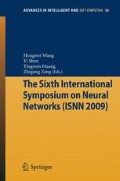Abstract
Epilepsy is a common chronic neurological disorder that is characterized by recurrent unprovoked seizures. About 50 million people worldwide have epilepsy at any one time. This paper presents an Intelligent Diagnostic System for Epilepsy using Artificial Neural Networks (ANNs). In this approach the feed-forward neural network has been trained using three ANN algorithms, the Back propagation algorithm (BPA,), the Radial Basis Function (RBF) and the Learning Vector Quantization (LVQ). The simulator has been developed using MATLAB and performance is compared by considering the metrics like accuracy of diagnosis, training time, number of neurons, number of epochs etc. The results obtained clearly shows that the presented methods have improved the inference procedures and are advantageous over the conventional architectures on both efficiency and accuracy.
Access this chapter
Tax calculation will be finalised at checkout
Purchases are for personal use only
Preview
Unable to display preview. Download preview PDF.
References
Aliev, R.A., Aliev, R.R.: Soft Computing and its Applications. World Scientific Publishing Co. Pvt. Ltd., Singapore (2001)
Lisboa, P.J.G., Vellido, A., Wong, H.: Outstanding Issues for Clinical Decision Support with Neural Networks. J. Artificial Neural Networks in Medicine and Biology, 63–71 (2000)
Setiono, R., Huan, L.: Neurolinear: From Neural Networks to Oblique Decision rules. J. Neurocomputing, 1–24 (1997)
http://en.wikipedia.org/wiki/Epilepsy/ (accessed October 2007)
Del Rio, R.A., Foyaca-Sibat, H., LdeF Ibañez –Valdes: Neuroepidemiological Survey For Epilepsy, Knowledge About Epilepsy, Neurocysticercosis And HIV/Aids At The Makaula Village In South Africa. Internet Journal of Neurology 7, 2, ISSN: 1531-295X
Dua, T., De Boer, H.M., Prilipko, L.L., Saxena, S.: Epilepsy care in the world: Results of an ILAE/IBE/WHO global campaign against epilepsy survey. CODEN EPILAK 47(7), 1225–1231 (2006)
Neural Networks Toolbox in MATLAB
Freeman, J.A., Skapura, D.M.: Neural Networks. Addison-Wesley, Reading (1999)
Hecht–Nielsen, R.: Theory of the Backpropagation. In: Proceedings of the International Joint Conference on Neural Networks, vol. 1, pp. 593–606 (1989)
Widrow, B., Lehr, M.A.: 30 Years of Adaptive Neural Networks: Perceptron, Madaline and Backpropagation. Proc. IEEE 78(9), 1415–1441 (1990)
Orr, M.J.L.: Regularisation in the Selection of Radial Basis Function Centres, J. Neural Computation 7(3), 606–623 (1995)
Toh, K.A.[Kar-Ann], Mao, K.Z.: A Global Transformation Approach to RBF Neural Network Learning. In: ICPR 2002, vol. II, pp. 96–99 (2002)
Jankowski, N.: Approximation with RBF-type Neural Networks using flexible local and semi local transfer functions. In: 4th Conference on Neural Networks and Their Applications, pp. 77–82 (1999)
Ghosh, A., Biehl, M., Freking, A., Reents, G.: A Theoretical Framework for Analyzing the Dynamics of LVQ: A Statistical Physics approach, Technical Report 2004-9-02, Mathematics and Computing Science, University Groningen, P.O. Box 800, 9700 AV Groningen, Netherlands (2004), www.cs.rug.nl/~biehl
Hammer, B., Villmann, T.: Generalized Relevance Learning Vector Quantization. J. Neural Networks 15(8-9), 1059–1068 (2002)
Neural Networks Research Centre, Helsinki, Bibliography on the self-organizing maps (SOM) and learning vector quantization (LVQ), Helsinki Univ. of Technology, Otaniemi (2002), http://liinwww.ira.uka.de/bibliography/Neural/SOM.LVQ.html
Ghosh, A., Biehl, M., Freking, A., Reents, G.: A theoretical framework for analyzing the dynamics of LVQ: A statistical physics approach, University Groningen, P.O. Box 800, 9700 AV Groningen, The Netherlands, Technical Report 2004-9-02, Mathematics and Computing Science (2004)
UCI repository of machine learning databases (2007), http://archive.ics.uci.edu/ml/datasets.html
Author information
Authors and Affiliations
Editor information
Editors and Affiliations
Rights and permissions
Copyright information
© 2009 Springer-Verlag Berlin Heidelberg
About this chapter
Cite this chapter
Shukla, A., Tiwari, R., Kaur, P. (2009). Diagnosis of Epilepsy Disorders Using Artificial Neural Networks. In: Wang, H., Shen, Y., Huang, T., Zeng, Z. (eds) The Sixth International Symposium on Neural Networks (ISNN 2009). Advances in Intelligent and Soft Computing, vol 56. Springer, Berlin, Heidelberg. https://doi.org/10.1007/978-3-642-01216-7_86
Download citation
DOI: https://doi.org/10.1007/978-3-642-01216-7_86
Publisher Name: Springer, Berlin, Heidelberg
Print ISBN: 978-3-642-01215-0
Online ISBN: 978-3-642-01216-7
eBook Packages: EngineeringEngineering (R0)

